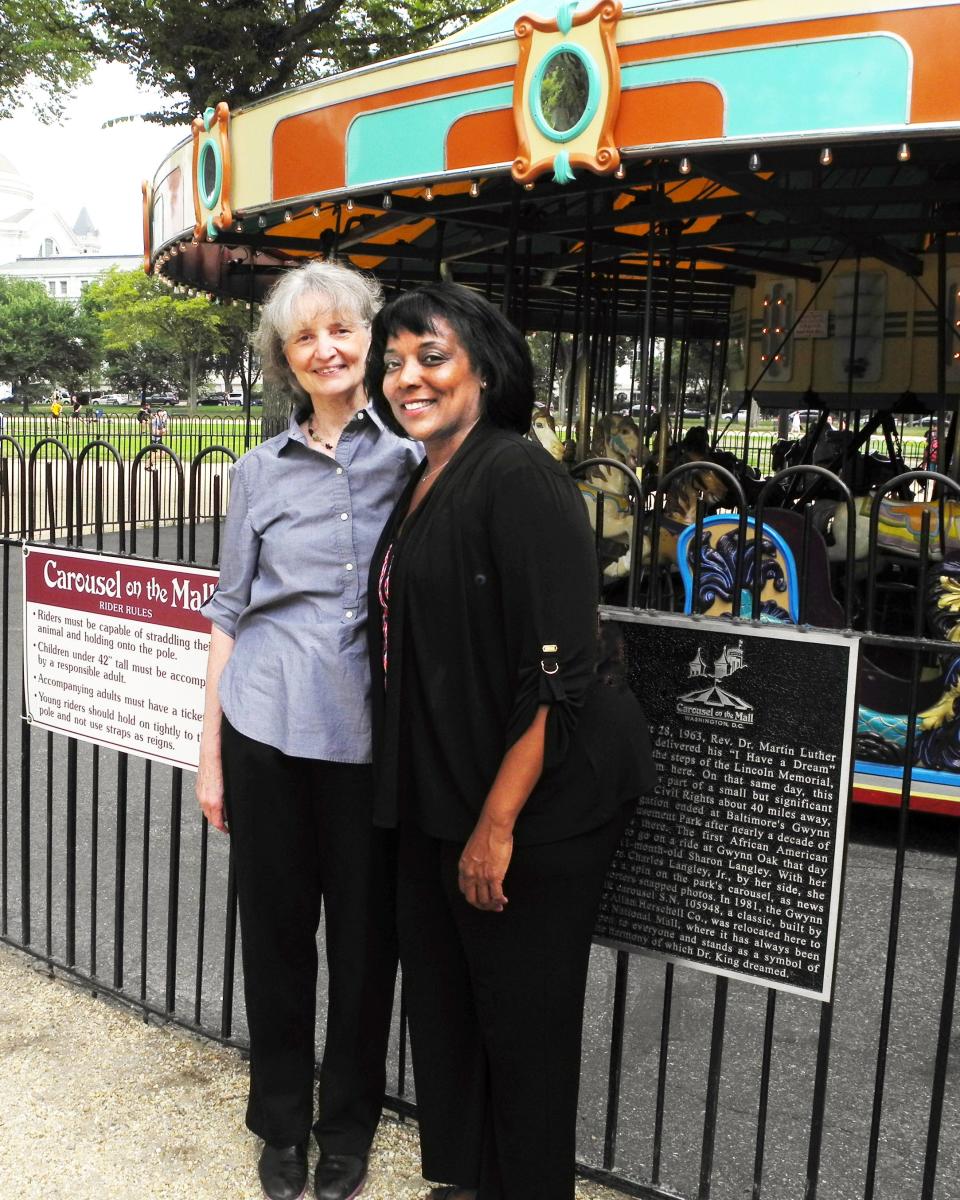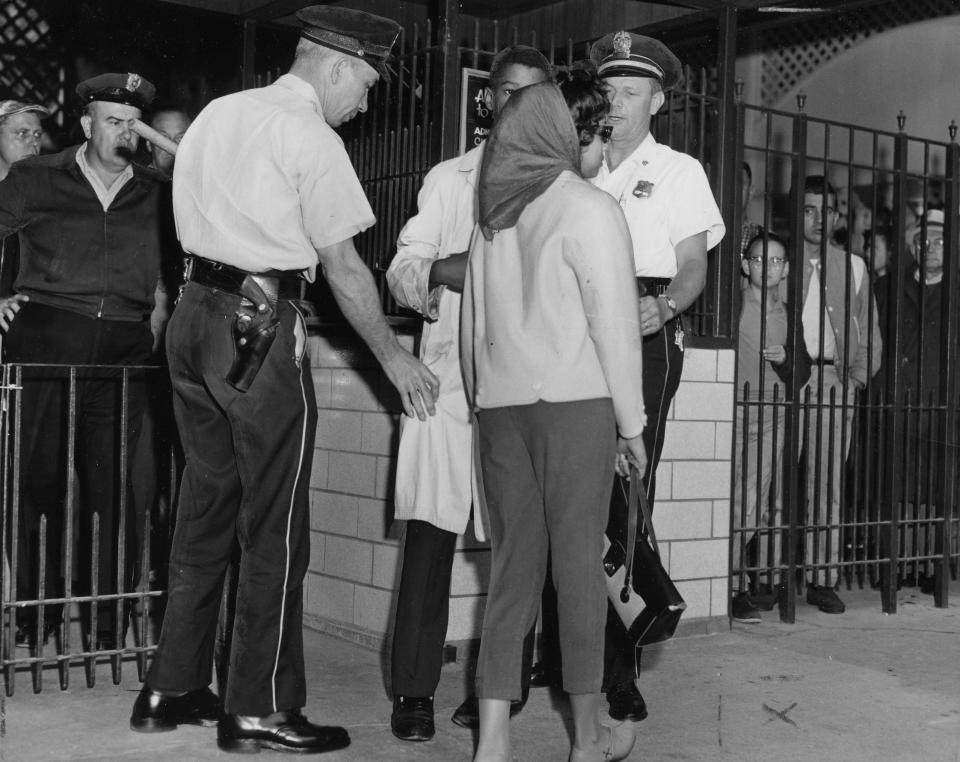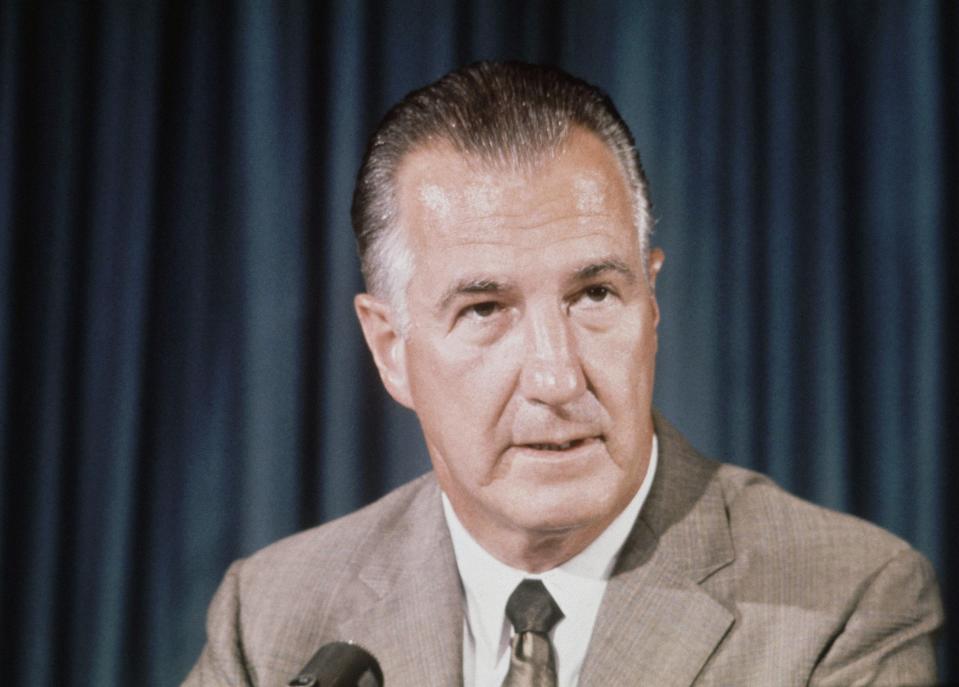60 years ago in Baltimore, a child's carousel ride marked the end of a civil rights journey
- Oops!Something went wrong.Please try again later.
In the photo, Sharon Langley is an infant girl of 11 months, dressed all in white atop a carousel pony in suburban Baltimore. Held in place by her father, she regards him with uncertain eyes, unaware of her role in civil rights history.
On this day, Aug. 28, 1963, Gwynn Oak Amusement Park welcomed Black people through its gates for the first time, and Sharon would become known as the first Black child to ride the park’s carousel, the very one that now graces the National Mall near the Smithsonian’s Arts and Industries Building in Washington, D.C.
Monday marks the 60th anniversary of the desegregation of Gwynn Oak, and while capital visitors might be largely unaware of the merry-go-round’s civil rights importance, the eight-year fight to desegregate the park where it once circled held significance even as the country grappled with far-reaching issues of national inequality.
The tide would turn when more than 400 people -- including more than 20 priests, pastors and rabbis -- were arrested over two days of protests in July 1963. The struggle showed the lengths to which a national battle for civil rights was being fought even on local fronts by people determined to make things right in their own backyard.
This is the little-known story of Gwynn Oak's desegregation and the carousel that, by chance, now sits on the National Mall not far from where Martin Luther King Jr. delivered his historic "I have a dream" speech on the same day as Langley's momentous ride.
Gwynn Oak was a symbol of an unfair system in which bias on the basis of skin color began in prepubescence, planting early notions of secondary status and bitterness in the minds of Black children while leaving them outside looking in – a theme touched on by King himself in his “Letter from Birmingham Jail.”
As King wrote, how do you explain to your young daughter why she can’t go into an amusement park where she sees other children her age smiling and laughing? How do you prevent “ominous clouds of inferiority” from forming in her psyche?
Charles Mason, who as a Baltimore chapter leader for the Congress of Racial Equality organized numerous protests calling for the park's desegregation, said it seemed few white kids themselves had any issue interacting with Black kids.
"But the adults had so much resistance," he said. "People thought Gwynn Oak was pivotal in the movement."
At Gwynn Oak, the “stinging darts of segregation” King referenced seemed increasingly unfair in the 1950s as more Black families populated surrounding neighborhoods. Some purposely avoided driving by the park so they wouldn’t face uncomfortable questions from their kids.
“People say, it was just an amusement park – what difference did it make?” said Langley, now 60 and living in the Los Angeles area. “It’s the importance of joy – I still love a drippy popsicle and watching the man make cotton candy cones. I still like balloons. Have you ever seen a kid on a merry-go-round and not seen them wave every time they go around? Your child has to have joy.”
'All you could do was stand outside, looking in'
Gwynn Oak had opened in 1894, a mom-and-pop amusement park in a countryside setting northwest of Baltimore County. It included a lake, picnic areas and a baseball field, and eventually bumper cars, a Ferris wheel and several rollercoasters.
Michael Furstenberg, a white 78-year-old clinical psychologist in Boston, remembers Gwynn Oak as a place he and other kids went with older siblings on weekend afternoons. “It was a Northwest Baltimore institution,” he said, even if “by today’s standards, it was old-fashioned.”
In 1947, the park added its carousel, according to Amy Nathan, author of “Round & Round Together: Taking a Merry-Go-Round Ride into the Civil Rights Movement.” Built by amusement park ride manufacturer Allan Herschell, its hand-carved wooden and aluminum ponies were so-called “jumpers,” with all four feet off the ground.

Linda Dorsey-Walker grew up in nearby Forest Park, a once-Jewish hamlet into which many Black middle-class families, including her own, had moved by the 1950s. As a youngster, she said, she and her friends would ride their bikes to Gwynn Oak and challenge the owners to let them enter.
“Everyone who was African American knew you couldn’t get in,” said Dorsey-Walker, 69, a retired Maryland health care administrator. “You could go past the park and see and hear families having fun, but all you could do was stand outside looking in.”
Gwynn Oak was segregated from the start, with employees whose families had worked there for generations; many lived on a hill overlooking the park entrance. Some, Dorsey-Walker said, would emerge from those houses to taunt the Black kids as they’d arrive.
“They saw us as a threat to their neighborhood business,” she said. “They took it very personally.”
The abuse ultimately became worse.
Civil rights successes inspire demands to integrate Gwynn Oak
With Baltimore County divided between Southern attitudes and more progressive city leadership, the civil rights organization Congress of Racial Equality (CORE) launched its Baltimore chapter in 1952, conducting successful restaurant sit-ins at department store lunch counters throughout the decade.
Baltimore schools largely complied when the U.S. Supreme Court issued its 1954 decision in Brown v. Board of Education, ordering desegregation of public schools.
“The city was changing, and that was exciting,” Furstenberg said. “I was in fourth grade when that happened. Whites started moving out of my neighborhood and Blacks started coming in.”

While segregated amusement parks weren’t uncommon at the time, civil rights successes made Baltimore activists hungry for change. They made Gwynn Oak a focus of desegregation starting in 1955.
When negotiations with park owner Arthur Price Sr. failed and picketing had little effect on attendance, CORE hit the park’s All Nations Festival, a Labor Day weekend event inviting cultural displays and foods from countries around the world – except for Africa.
Demonstrators handed out leaflets citing the hypocrisy of having Black soldiers fight for the U.S. but banned from the park. Arthur Price Jr., who managed the park with his brothers, wouldn’t budge.
In 1959, protesters started walking past the gates into the park in mixed groups of white and Black, prompting beatings by patrons and arrests by police that raised media coverage. Price told reporters integrating the park would be “economic suicide,” fearing white people would no longer come.
Meanwhile, CORE’s efforts had convinced many hotels, movie theaters and downtown department stores to integrate; in 1961, the group-led Route 40 campaign forced restaurants along the main highway linking Baltimore to Washington, D.C., to do the same.
In March 1963, when Dorsey-Walker was 9, Maryland approved a public accommodations law, outlawing discrimination in all hotels and restaurants. That news, she said, “spread like wildfire in African American communities” and hardened the youngsters’ determination to challenge park policies.
However, the law did not include amusement parks – so when she and her friends rode up to Gwynn Oak brandishing a copy of an article about the new law, gatekeepers tore it up and turned them away again.
Ultimately, CORE leaders decided they needed a different approach. They looked to tactics employed by civil rights activists in the South, including a bus boycott in Montgomery, Alabama; widespread student sit-ins protesting discrimination at restaurants; and “jail-no-bail” practices in which arrested protesters refused bail as a means of overwhelming local jail systems.
“They learned from the protests going on down South that they had to be more assertive,” Nathan said. “They had to impose economic hardship in order to bring about change.”
Clergy help ramp up the demonstrations
Dorsey-Walker had experienced hate from an early age. At 5, a white resident unhappy about the neighborhood’s newly integrated elementary school burned through her skirt with a cigarette as she walked home, she said, and the following year, she and a cousin were dragged out by their collars from a whites-only diner when they went in seeking water.
“That’s how we were treated on a regular basis,” Dorsey-Walker said. “That’s why when it came time to speak up, I knew I wasn’t going to put up with that.”
At Gwynn Oak, she and her friends continued to plead their case outside the gates. She recalled adults spitting in their faces, punching and hitting them with sticks and running them out of the area.
Dorsey-Walker’s father worked for the U.S. Department of Defense, and her parents had taught her not to respond with violence.
“He and my mother taught us to have a lot of backbone – but don’t make him lose his job,” she said. “They didn’t want us identified as rabble-rousers.”
CORE decided it was time to ramp up the protests and overwhelm the park and area jails with sheer numbers. Meanwhile, the National Council of Churches had concluded in June that religious leaders should no longer remain on the civil rights sidelines, so when CORE announced a massive 4th of July protest, dozens of priests, rabbis and pastors were ready.
On that day, as author Nathan recounted, hundreds of protesters confronted throngs of segregationists throwing rocks, shouting slurs and carrying signs reading “Keep Gwynn Oak White” and “U.S. for Whites – Africa for Blacks.”
More than 20 clergy members were arrested.
“That was a first in civil rights history to have so many clergy, particularly white clergy, arrested in a single demonstration,” Nathan said.
Stuart Wechsler, then a member of a CORE chapter in New York, recalled being part of a group of activists who impulsively attempted to enter the park from the back, intending to ford a stream near some rowhouses but instead being surrounded by a menacing crowd.
A quick-thinking protester began singing the national anthem, he said. The others joined in, prompting the mob to stand at respectful attention before it closed in again.
“We continued singing until the police arrived and placed us under arrest,” Wechsler said. “I never returned to Gwynn Oak.”
On Sunday, July 7, CORE conducted another massive protest, with 300 demonstrators.
Furstenberg, a college sophomore, was home for summer and eager to participate in the protests. He ended up in a jail cell accused of violating Maryland's trespass law with two dozen others including Yale University chaplain William Sloane Coffin, a renowned peace activist who conducted a seminar of sorts on world events for his captive audience.
In all, more than 400 activists were arrested in those two days, including two dozen clergy members. At least two families, along with their kids, were taken into custody.

Furstenberg recalled a festive air and prevailing sense of inevitability among demonstrators despite the antagonism they faced.
“There was a sense that Baltimore was ready for this,” he said. “So even though we knew we were going to get arrested, we knew it (desegregating Gwynn Oak) was going to happen.”
The historic carousel survives the park's demise
The spectacle of protests and national coverage was finally too much for Baltimore officials to stomach. County executive Spiro Agnew and the county’s new human relations commission made the park’s integration their number-one priority.
“Agnew was trying to persuade people that Baltimore County was a good place to do business, and here was all this bad publicity with Catholic priests and children being arrested,” Nathan said.
Within two weeks, the Price family agreed to integrate – on August 28, the same day as the March on Washington.
With the park’s integration, many white families vowed never to return. But the forces that left the park limping along by 1971 encompassed much more – including the growing popularity of automotive travel and the rise of elaborate destinations such as Six Flags that made places like Gwynn Oak seem clunky and quaint by comparison.
The next year, Hurricane Agnes pummeled the mid-Atlantic, killing more than 100 and destroying 300-plus homes. Gwynn Oak was deluged, its rides and attractions irreparably ruined. The carousel was all that survived.
In 1981, National Mall concessionaire Jim Wells, seeking to replace his aging merry-go-round, bought the Gwynn Oak carousel. It was later sold to Stan and Donna Hunter who, after learning of its historic role, outfitted the horse Langley rode in a Freedom Riders theme.
Now owned by the Smithsonian, the carousel is being restored with completion planned by 2026, the nation’s 250th anniversary.
At last, a historic ride begins
On Wednesday, Aug. 28, 1963, the carousel at Gwynn Oak spun just as it had on many days before, only this day was different: Baltimore's long segregated park was opening its doors to Black people for the first time.
Some 43 miles to the south, hundreds of thousands had swamped the National Mall in Washington, D.C., for King's much-anticipated March on Washington for Jobs and Freedom. Meanwhile, at Gwynn Oak, Black families braved a gauntlet of anti-integration protesters and police officers to enjoy their neighborhood amusement park without incident.
Charles Langley Jr., a Social Security Administration supply clerk, and wife Marian, a hospital nurse, had hoped to attend the Washington march with federal offices shut down for the event and Marian not on duty until nightfall. But when they couldn’t find a sitter for 11-month-old daughter Sharon, they opted to visit Gwynn Oak instead.
Their visit lasted barely an hour, with a stop by the arcade games and then the park’s carousel. Sharon's father lifted her onto a pony, where she regarded him uncertainly as he held her in place.
Two young white boys mounted horses just behind them and their mother asked Langley if he could keep an eye on them while they rode.
It was a small gesture, one seemingly trivial today but rich with significance at the time — the kind of thing, Langley thought to himself, that made him feel he and his family would finally be accepted.
This article originally appeared on USA TODAY: Integration of Baltimore amusement park led to historic carousel ride

